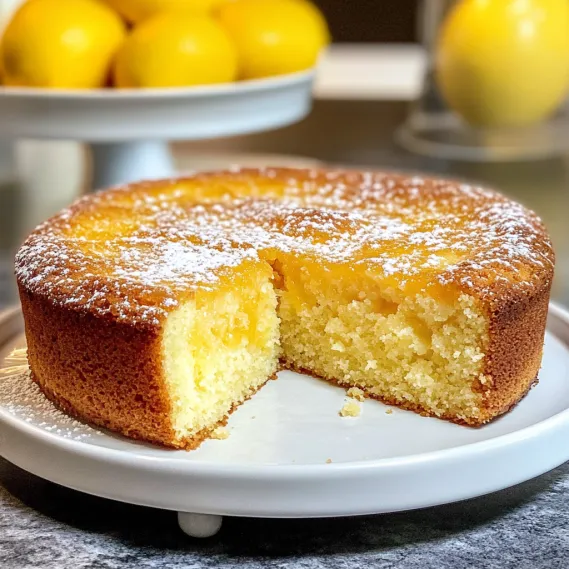 Pin it
Pin it
This irresistible lemon curd cake delivers an explosion of bright citrus flavor in every bite. The buttery, tender cake base provides the perfect canvas for generous swirls of luscious lemon curd that create pockets of sweet-tangy goodness throughout. As it bakes, the cake develops a delicate golden crust while maintaining a wonderfully moist interior studded with gooey lemon treasures. Simple yet sophisticated, this easy-to-make cake transforms basic ingredients into a showstopping dessert that perfectly balances sweetness with refreshing lemon brightness.
I first made this cake when looking for a simple yet special weekend breakfast treat. What began as an experiment has become my most requested recipe for spring and summer gatherings. The contrast between the sweet cake and tangy lemon curd creates an irresistible flavor combination that appeals to everyone - even those who typically don't gravitate toward lemon desserts. My neighbor, who claimed not to enjoy lemon treats, asked for the recipe after tasting just one slice!
Essential Ingredients and Selection Tips
- All-Purpose Flour: Provides structure while maintaining tenderness. Measuring precisely ensures the perfect texture.
- Butter: Use good quality butter at proper room temperature (should indent slightly when pressed but not be overly soft).
- Eggs: Large eggs provide moisture and richness. Bring to room temperature for better incorporation.
- Lemon Curd: The star ingredient! Store-bought works beautifully, but homemade elevates this cake to extraordinary heights.
- Sugar: Regular granulated sugar works perfectly for this recipe, creating just the right level of sweetness.
The quality of your lemon curd makes a tremendous difference in this cake. I've found that homemade lemon curd with its vibrant flavor and silky texture creates the most spectacular result, but a good-quality store-bought version will still produce a delicious cake. Look for lemon curd with a bright yellow color and actual lemon zest visible in the jar for the best flavor.
Detailed Cooking Instructions
- Step 1: Prepare Your Baking Foundation
- Preheat your oven to 350°F (180°C). Line an 8-inch round cake pan with parchment paper, with some overhang to help with removal later, or thoroughly grease with butter. Position a baking sheet on the rack below where you'll place the cake as insurance against any possible overflow.
- Step 2: Create The Perfect Dry Mixture
- In a medium bowl, whisk together 2 cups all-purpose flour, 2 teaspoons baking powder, and 1/2 teaspoon salt until thoroughly combined. This even distribution of leavening agents ensures your cake rises uniformly. Set this mixture aside while you prepare the wet ingredients.
- Step 3: Develop The Cake Base
- In a larger bowl, beat 3/4 cup sugar and 6 ounces (1 1/2 sticks) room temperature butter until light and fluffy, about 2-3 minutes. Add 3 large eggs one at a time, beating well after each addition to incorporate air into the batter. Mix in 6 ounces (half) of the lemon curd until fully combined, creating a smooth, creamy base.
- Step 4: Combine With Care
- Gently fold the flour mixture into the wet ingredients using a spatula or wooden spoon. Use broad, sweeping motions to incorporate without overmixing, which would develop gluten and toughen the cake. Continue folding just until no dry streaks remain and the batter is smooth and well-blended.
- Step 5: Create Lemon Pockets And Bake
- Spoon the cake batter into your prepared pan, spreading it evenly to the edges. Using a teaspoon, drop dollops of the remaining 6 ounces of lemon curd randomly over the surface. Leave them as is or lightly swirl with a knife tip for a marbled effect. Bake for 40 minutes until the top is golden brown, though the center may still have a slight jiggle. Cool completely in the pan before turning out and removing parchment paper. Dust with confectioners' sugar just before serving, if desired.
 Pin it
Pin it
I discovered the importance of proper pan size through trial and error. My first attempt in a smaller pan resulted in a dramatic overflow that created quite a mess in my oven! Now I always place a baking sheet underneath as insurance, which has saved me cleanup on more than one occasion when the cake bubbles enthusiastically during baking.
The Secret To Perfect Texture
The remarkable texture of this cake comes from the careful balance of ingredients and technique. The butter provides richness while creating tiny air pockets during creaming that expand in the oven. The eggs contribute structure and moisture, while the lemon curd adds incredible tenderness to the crumb. I've found that room temperature ingredients are absolutely crucial - cold eggs or butter can result in a dense, uneven texture. Another key factor is proper measuring of the flour. I prefer the spoon-and-level method rather than scooping directly with the measuring cup, which can pack too much flour into the measure and create a dry cake. My daughter once made this cake using the scoop method, and the difference in texture was immediately noticeable - much heavier and less tender than the properly measured version.
Seasonal Variations Worth Trying
While this classic lemon version is perfect year-round, I've developed several seasonal adaptations that showcase the versatility of this recipe. In summer, I sometimes fold 1 cup of fresh blueberries into the batter before adding the lemon curd dollops - the combination of blueberry and lemon is absolutely divine. For fall gatherings, I've experimented with orange curd instead of lemon, adding 1/2 teaspoon of cinnamon to the batter for a warm, autumnal flavor profile. During the winter holidays, I've created a cranberry version using homemade cranberry curd that provides a beautiful ruby color and tart flavor that complements festive meals. My family's favorite variation might be the spring version where I add 1-2 tablespoons of finely chopped fresh basil to the batter for a sophisticated herb-citrus combination that's unexpected and delightful.
Perfect Pairing Suggestions
While this cake is certainly delicious on its own, there are several accompaniments that elevate it to an even more special treat. For breakfast or brunch, I serve it alongside fresh berries and a dollop of Greek yogurt, which complements the sweetness perfectly. As an afternoon treat with tea, a small scoop of clotted cream on the side makes it feel like a proper English tea service. For dessert, a spoonful of lightly sweetened whipped cream and a sprinkle of lemon zest creates an elegant presentation. My personal favorite pairing is with a scoop of good vanilla ice cream - the contrast between the cold, creamy ice cream and the tender, lemony cake creates a dessert experience that's greater than the sum of its parts.
Make-Ahead And Storage Tips
This cake is truly at its best on the day it's baked, when the contrast between the tender cake and pockets of lemon curd is most pronounced. However, I've found that it can be prepared in stages if needed for busy days. The batter can be made up to an hour ahead and kept at room temperature before baking. Once baked and completely cooled, the cake will keep for one additional day stored in an airtight container. If you do need to store leftovers, I recommend against refrigeration as it tends to dry out the cake - instead, store at room temperature and enjoy within 24 hours. To refresh day-old cake, a brief 10-second warming in the microwave brings back some of the just-baked texture, and serving with cream or ice cream adds moisture that compensates for any slight drying.
 Pin it
Pin it
This lemon curd cake has become my signature spring and summer dessert, the one that friends and family request for gatherings and special occasions. There's something magical about the way the simple ingredients transform into something so much greater than the sum of their parts. The beauty of this cake lies in its simplicity - straightforward ingredients combined with easy techniques that result in an impressive and delicious treat that never fails to delight everyone who tastes it.
Frequently Asked Questions
- → Can I make my own lemon curd for this recipe?
- Absolutely! While store-bought lemon curd works perfectly fine, homemade lemon curd can take this cake to another level. For a simple homemade version, whisk together 3 eggs, 3/4 cup sugar, zest of 2 lemons, 1/2 cup fresh lemon juice, and 4 tablespoons butter in a saucepan over medium-low heat, stirring constantly until thickened (about 10 minutes). Strain and cool completely before using in the cake. Homemade curd tends to be fresher tasting and you can adjust the tartness to your preference.
- → Why is my cake still jiggly in the center when I take it out of the oven?
- This is normal and actually desired for this particular cake! The areas where you dropped spoonfuls of lemon curd on top will remain a bit jiggly even when the cake is done. The cake should be golden brown on top and the edges should be set, but the center may still have some movement - this creates the gooey pockets that make this cake special. As the cake cools, it will firm up somewhat, though it will retain those delicious moist lemon curd pockets. If you bake until completely firm, you'll lose the signature gooey texture that gives this cake its appeal.
- → Can I make this cake ahead of time?
- Yes, this cake can be made 1-2 days ahead of time. Once completely cooled, store it in an airtight container at room temperature for one day or in the refrigerator for up to three days. If refrigerated, bring to room temperature before serving for the best flavor and texture. For the freshest presentation, wait to dust with confectioners' sugar until just before serving. This cake actually develops a deeper lemon flavor after resting for a day, making it an excellent make-ahead dessert option.
- → Can I freeze this lemon curd cake?
- While you can freeze this cake, the texture of the gooey lemon curd pockets will change somewhat after thawing. If you do want to freeze it, wrap the completely cooled cake tightly in plastic wrap, then aluminum foil, and freeze for up to 3 months. Thaw overnight in the refrigerator, then bring to room temperature before serving. Another option is to freeze individual slices, which thaw more quickly. The flavor will still be delicious, though the contrast between cake and curd areas might be less pronounced than in a freshly baked cake.
- → What can I serve with this lemon curd cake?
- This cake is delicious on its own with just a dusting of confectioners' sugar, but there are several ways to elevate it for serving: 1) A dollop of lightly sweetened whipped cream adds a creamy contrast; 2) Fresh berries like raspberries, blueberries, or strawberries complement the lemon flavor beautifully; 3) A scoop of vanilla ice cream turns it into a more decadent dessert; 4) For a triple lemon treat, serve with an additional small dish of lemon curd on the side; or 5) A drizzle of warm berry coulis creates an impressive color contrast and flavor pairing.
- → My cake sank in the middle after cooling. Did I do something wrong?
- Don't worry - some sinking is normal for this particular cake! Because of the pockets of lemon curd, this cake naturally settles and shrinks a bit as it cools. This is part of its charm and creates that dense, moist texture. If the cake sank dramatically, it might have been slightly underbaked, or your oven temperature might be running low. Using a slightly larger pan (9-inch instead of 8-inch) can also help with this issue. Remember that this isn't a typical light and fluffy cake - it's meant to be more dense and moist, somewhat like a cross between a cake and a pudding in texture.
